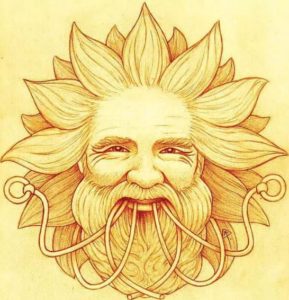
Wren Day (Lá Dreoilín) is a traditional Irish custom where the bold and mysterious ‘Wren Boys’ perform a ceremonial ‘Hunt of the Wren’, which takes place on Christmas Day or Chrismas Eve, followed by a parade on the 26th of December, or Saint Stephen’s Day, each year.
While its true origins are unknown, it is clearly quite ancient, today it reflects a fusion of Ireland’s Christian beliefs with its ancient pagan customs.
Other names:
It is also known as the ‘Day of the Wren’, ‘Wren’s Day’, ‘Wrenning Day’, or the ‘Hunt of the Wren Day’.

As we pass the Winter Solstice, as Newgrange gets her annual fill of renewing sunlight, we are reminded how significant this dark and dead part of the year was to ancestors.
Far from being a time of remorse and regret, this was a time of hope and celebration.

The Sun had conquered death once again, it had descended for many months as the nights got longer and colder.
The Solstice is a time of victory for the sun, like the phoenix it rises again to bring light, life, and warmth to the world.
In a sense, the ceremony of the ‘Wren Day’ and the play of the Mummers represents a human effort to reenact this same symbology, that is, the conquering of winter and darkness through the symbolic hunt of the wren bird.
Why choose the poor little wren bird?
What is the symbolic meaning behind the wren and of Wren Day?
Read on to find out…
Description of the event
On Wren Day each year, the boys dress up in straw costumes, masks, and face-paint, some wear flamboyant costumes and colourful ribbons, before setting off on the ‘Hunt of the Wren’.
The dressed-up crowds are known as the ‘wren boys’, who are also called the ‘strawboys’ or ‘mummers’.
A detailed description of the stages of the ritual can be found here.
In earlier times, the bird was actually hunted and killed by the Wren Boys, preferably with a stone, but today an effigy of the wren is mostly used.
This effigy could be anything from a ball of moss and leaves to a dummy bird with feathers glued on or something similar.
The wren is
… hunted and killed by the peasants on Christmas Day, and on the following (St. Stephen’s Day) he is carried about, hung by the leg, in the centre of two hoops, crossing each other at right angles, and a procession made in every village, of men, women, and children, singing an Irish catch, importing him to be the king of all birds.
– The Golden Bough, James Frazer.
With music and pomp, they parade through the towns and villages carrying their catch high on a pole for all to see, though usually the bird is concealed in a box or cage which obscures it from view.
The banner-man who is charged with carrying the wren-pole maintains a safe distance from the gathered crowds who will clamour to get a look and see if they have a real bird or not – if they are found to be spoofing by using an effigy, the boys themselves become the victims of playful jeering and banter.
Moving from house to house, and even from village to village and town to town, the Wren Boys collected money along their route singing something like…

[F] The wren, the wren, the [C7] king of all the birds
On [F] Stephen’s Day was [C7] caught in a furze
[F]Though he was little, his [C7] honour was great
So [F] give us a [Bb] penny to [C7] give us a [F] treat.
My box would speak if it had a tongue
And two or three coppers can do it no wrong
Sing holly, sing ivy, sing ivy sing holly
A drop just to drink it would drown melancholy.
And if you draw it of the best
I hope in heaven your soul may rest
But if you draw if of the small
I won’t agree with the Wrenboys at all.
Missus you’re a very fine woman
A very fine woman, a very fine woman
Missus you’re a very fine woman
You gave us a penny to bury the wren.
There are a number of variations of this sort found in different locations still following the custom.
The wren the wren the king of all birds
St Stephen’s Day was caught in the furze
Her clothes were all torn- her shoes were all worn
Up with the kettle and down with the pan
Give us a penny to bury the “wran”
If you haven’t a penny a halfpenny will do
If you haven’t a halfpenny God bless you!
This parading of the wren could happen for many weekends on into late January or even until February.
Those who gave were rewarded with a token of good luck; a wren’s feather. Those who were stingy and refused were cursed by the straw boys who buried the dead bird on their property, a sign that was believed to lead to bad luck and ill-fortune.

In the past, people who contributed to the boys’ funds were given a feather plucked from the wren, a token considered good luck.
But retribution could await those folks who refused charity, for the boys, as a traditional means of cursing the person, would bury the dead bird on his or her property.
The funds raised were then put together to hold a party for the community called a ‘join’ which took place at some later date and in someone’s home. All food and refreshments provided for, including a generous amount of port for the men and wine for the women.
The wren boys appeared and often performed acts or plays for the attendees.
In modern times, sometimes the funds are donated to a community centre, school, or project, and traditionally a small amount is always donated to a needy person in the community.
The symbolism of the wren bird
By many European peoples—the ancient Greeks and Romans, the modern Italians, Spaniards, French, Germans, Dutch, Danes, Swedes, English, and Welsh—the wren has been designated the king, the little king, the king of birds, the hedge king, and so forth, and has been reckoned amongst those birds which it is extremely unlucky to kill. In England it is supposed that if any one kills a wren or harries its nest, he will infallibly break a bone or meet with some dreadful misfortune within the year; sometimes it is thought that the cows will give bloody milk.
– The Golden Bough, James Frazer.
Symbology is a science of interpretation, it is layered, its nature is one of evolving context and complexity.
There’s the symbolism of the wren bird itself, both generally speaking and in the context of Irish folk-thought specifically; then there’s the symbolism of the ‘Hunt of the Wren’.
There are a number of source theories for the custom, we shall consider a few of these but I will save my preferred theory, the Celtic Theory for last.
First, on the symbolism of the wren: it is said to be the first and loudest bird to sing in the morning, here we find its association with the sun as it is its chief herald or ‘king among birds’.
Its name in Irish, dreolín, is noted for its connection with the words for a druid (druí) or magic (draoi-, draoicht); here the name is thought to derive from a contraction of the words draoi– and éan (a ‘bird), to mean ‘druid-bird’, or ‘magic-bird’.
Druids are thought to have consulted the song of the wren to divine omens and uncover secret truths, in this way they were seen as messengers of the gods.
This connection with the druids is further highlighted by the line in the Irish Wren Boy’s Song “Sing holly, sing ivy, sing ivy, sing holly.”
It can soar to great heights in the sky or be found scurrying among the underbrush.
In many other languages, we see a similar reverence for the wren and recognition of its status as a king among birds.
Like the Irish, their Manx cousins call the wren dreain, meaning ‘druid’s bird’; while their other cousins the Welsh call it dryw, meaning ‘wise’; to the Teutons it was koning vogel, or ‘king bird’, in Dutch konije, ‘little-king’; in French he is reytelet, and in Latin he was regulus, or ‘little king’.
However, for its treachery and deceptive character and cunning, it is sometimes called ‘the devil’s bird’ in Ireland.
They also have a connection to caves being of the trogoldytidae species.
Their connection to these dark cavernous places deep inside the hollow of the earth makes them creatures who can live either under the earth, on the surface, or in the air.
Caves are also thought to be a place of initiation for druids.
The wren has also featured in old poetry and myth:
He who shall hurt the little wren
Shall never be belov’d by men.
– William Blake Auguries of Innocence
A Robin and a wren
Are God Almighty’s cock and hen.
– Old Distich
I never take away their nest nor try
To catch the old ones, lest a friend should die
Dick took a wren’s nest from his cottage side.
And ere a twelvemonth past his mother dy’d!
– An Old Poet
The wren was said to be married to the robin, another bird with mythological and symbolic significance, here the wren represents the darkness of winter while the robin represents the joys of light and the coming spring.
While the wren is considered fair game on Wren Day, at any other time it was considered taboo to disturb the nests of the wren and transgressions were frowned upon; in some places, I have seen it suggested that the druids place a curse upon those who disturbed the wren outside of this sanctioned time.

So why is the wren bird hunted during Wren Day?
There are a few reasons suggesting why the wren is hunted on Wren Day, however, it is difficult to identify the true origins with certainty.
One thing’s for sure, the somewhat unfamiliar costumes, symbols, and plays reflect a pre-Christian origin, even if today’s Wren Day ceremony mixes with the mythology of the Christian Saint Stephen’s day.
Among the Christian myths of the wren there is a story told in Ireland; God had a desire to know who was the king of all birds, so he decided to set a challenge to find out.
Of all the birds, whichever could soar to the highest heights and sustain the longest distance would be crowned king of the birds.
Together the birds began to fly into the sky, higher and higher, soon they began to drop off one by one until eventually the only bird left flying was the eagle who also began to grow tired lose his height – suddenly, the wren, who had been sneakily hiding cleverly under the wing of the eagle, swooped out from under the wing and began to climb higher and for further than any of the other birds.
So, why was this little bird hunted?
Well, apart from its cunning nature it is also seen to be a betrayer and a traitor.
One folk theory relates to a time during the Viking Age when the Norsemen were occupying a number of strongholds in Ireland.
A legend tells how an ambush of a Viking settlement was thwarted when a wren beat its wings on their drums alerting the enemy to the Irish warriors who had surrounded them and lay secretly in waiting for their moment to strike.
A variant of this tale sets it during the penal times and at a British Army camp, here the wren pecks his beak on the sleeping soldier’s drum.
And another Christian legend connects the bird to Saint Stephen as his betrayer when by chance a wren revealed him to his captors and would-be killers.
However, this last tale is purely apocryphal as it seems the only real Christian connection to the Hunt is that it falls on the same day as the Saint’s.
The play of the Mummers
As described above, the play of the Mummers during Wren Day involves a symbolic interpretation of a struggle between lightness and darkness which is manifest in the very changing of the seasons occurring at this special time of the year.
But in addition to the hunt, the Mummers perform other more elaborate plays with a mixture of well-known characters from Irish myth, history, and even religion, battling nonsense. Invariably this results in the triumph of the goodies over the baddies, that is the forces of light over darkness, spring over winter.
A good description of one of the Wren Day Mummer’s plays can be found here.
Similar plays were performed in pre-Christian Ireland during funeral rites and civil ceremonies.
Anthropologists have interpreted these sorts of plays to derive from primitive magical beliefs, that is, the belief in man that he could influence or honour the natural forces, or the deities, around him, by symbolic interpretation and reenactment through drama, play, or ceremony, which is exactly what we see with the play of the Mummers on Wren Day.

When did it originate?
It is difficult to say, but one theory suggests it might have been introduced during the Viking Age (800-1169), and this connects to the previous legend of the wren betraying the warriors by beating its wings on the shields.
Norse mythology can be grouped under the wider umbrella of pre-Christian European beliefs, of which Irish mythology and Celtic mythology are also part, so it should not be surprising to find common themes or borrowed words or customs among these early European people.
There is strong evidence to suggest a Celtic or even Gaelic origin of the custom. Variants of the ritual can be found in Wales, the Isle of Man, and some parts of England, though not in Scotland.
In Wales, Lleu Llaw Gyffes, or ‘Lu the skillful hand’, is the equivalent of the Irish Lugh Lámhfada Samildánach, or ‘Lugh the long-armed master of the arts’, who won his name in the Welsh myths when hs skillfully kills a wren by striking it with a stone between the bone of its leg and its tendons.
In the Manx mythos, the Hunt of the Wren is based on the story a queen of the fairies and ancient sorceress named Tehi Tegi, meaning ‘beautiful gatherer’, of whom it is said led men who were enamored her glamour and wanted to marry her to their deaths by drowning.
When she was finally confronted with her crimes she shapeshifted into a wren to avoid punishment and flew away.
Banished from the Isle of Mann from then on, she returns just once a year, on Wren’s Day, or St. Stephen’s Day for the hunt.

Consider the similar Irish legend of Clíodhna (Clíona, pr. kleena). Clíodhna was a high-ranking fairy queen of the Túatha Dé Danann, who were the spirit-folk or fairy people who live in the otherworld under the sidhe [pr. shee] or hills of Ireland.
She is sometimes thought of as the first banshee or the queen of the banshees and in other forms she was a goddess of hunting and of feasting who had a strong presence in Munster.
Like with the Manx legends of Tehi Tegi, Clíodhna, too, has a dark side.
She was said to beguile men leading them to their deaths with her captivating beauty and alluring magical charm, but her association to wren in Ireland is different. Here, the story goes that a mortal man managed to get close enough to Clíodhna to learn some of her magical secrets. He developed a charm to protect against her magic and he plotted to thwart her.
Realising his plan, Clíodhna takes the form of a wren and flies away to the otherworld but she is punished for crimes against man by having to return in the form of a wren each Christmas, fated to die at human hands again and again.
Variations in other countries
As we have seen, there are variations of Wren Day in many countries and under various names.
In addition to the Isle of Mann and Wales, we find a strikingly similar tradition as far afield as Carcassonne, in southern France, in a wren-hunting ritual called Fête du Roi de l’Oiseau, The King of the Birds Festival, only here, the killer of the bird becomes a symbolic king.
Thus at Carcassone, every year on the first Sunday of December the young people of the street Saint Jean used to go out of the town armed with sticks, with which they beat the bushes, looking for wrens. The first to strike down one of these birds was proclaimed King. Then they returned to the town in procession, headed by the King, who carried the wren on a pole.
On the evening of the last day of the year the King and all who had hunted the wren marched through the streets of the town to the light of torches, with drums beating and fifes playing in front of them. At the door of every house they stopped, and one of them wrote with chalk on the door vive le roi! with the number of the year which was about to begin.
On the morning of Twelfth Day the King again marched in procession with great pomp, wearing a crown and a blue mantle and carrying a sceptre. In front of him was borne the wren fastened to the top of a pole, which was adorned with a verdant wreath of olive, of oak, and sometimes of mistletoe grown on an oak.
After hearing high mass in the parish church of St. Vincent, surrounded by his officers and guards, the King visited the bishop, the mayor, the magistrates, and the chief inhabitants, collecting money to defray the expenses of the royal banquet which took place in the evening and wound up with a dance.
– The Golden Bough, James Frazer.
The Wren Boys Today

Unfortunately, the Wren Boys are becoming a rarer sight in modern Ireland, like so many of the old ways and customs, and like with the language itself, most Irish people seem no longer interested, or perhaps no longer informed, about their ancient traditions. Thankfully, however, all hope is not lost. There are still pockets of mummers and straw boys to be seen parading their wrens across certain villages and towns across Ireland each year. Notably, the tradition remains strong in the west, in counties Mayo and Sligo, but there is also a strong unbroken tradition to be found in Fingal, North County Dublin.



